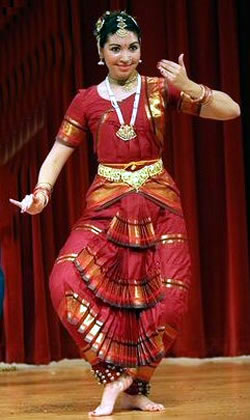 This dance form was primarily a temple ritual but was later altered to the royal court entertainment by the Persian and Mughal influences. Kathak was initially very similar to Bharatanatyam. This dance form originated in the North. The word kathak derived from "Katha", literally means story teller. Music and dance were used by story tellers to illuminate the story while attacking the sensibilities of the audience. This took the form of Kathkalakshepam and Harikatha in Southern India, and the form of Kathak in the North. Around the 15th century, the dance form underwent a drastic transition due to the influence of Mughal dance and music. By the sixteenth century, the tight churidar pyjama became the staple attire of a Kathak dancer.
This dance form was primarily a temple ritual but was later altered to the royal court entertainment by the Persian and Mughal influences. Kathak was initially very similar to Bharatanatyam. This dance form originated in the North. The word kathak derived from "Katha", literally means story teller. Music and dance were used by story tellers to illuminate the story while attacking the sensibilities of the audience. This took the form of Kathkalakshepam and Harikatha in Southern India, and the form of Kathak in the North. Around the 15th century, the dance form underwent a drastic transition due to the influence of Mughal dance and music. By the sixteenth century, the tight churidar pyjama became the staple attire of a Kathak dancer.
This north Indian dance form is inextricably bound with classical Hindustani music, and the rhythmic nimbleness of the feet is accompanied by the table or pakhawaj. Traditionally the stories were of Radha and Krishna, in the Natwari style but the Moghul invasion of North India had a serious impact on the dance. The dance was taken to Muslim courts and thus it became more entertaining and less religious in content. More emphasis was laid on nritta, the pure dance aspect and less on abhinaya (expression and emotion).
Kathak focuses more on footwork as compared to the hasta mudras or hand movements in Bharatanatyam. The dances are performed straight-legged and the ankle bells (ghungaroos) worn by the dancers are adeptly controlled. The costumes and themes of these dances are often similar to those in Mughal miniature paintings